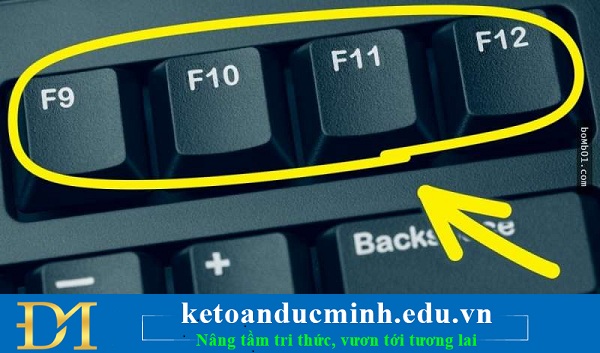Did you know all the keyboard shortcuts from F1-> F12?
I wonder what these shortcuts do? Let's find out the function of these 12 F shortcuts to use. After knowing the functions of these shortcuts, you will definitely use them a lot.
1. Make sure the F1 Key is functional

The F1 key is designed to open a Help window, also called a help window
The F1 key is designed to open the Help window, also called the help window, the Windows user manual and the software that you have installed on your Windows computer.
It is in the process of using Windows, and in rescuing the computer, the F1 key is sometimes a shortcut to access the BIOS of some computer lines.
For Windows XP, a few cases when booting the computer must press F1 to access the Windows operating system.
If you are working with Windows Explorer, Ctrl + F1 will help you hide / show the Task Pane.
2. Probably the F2 key

Use the F2 key to rename the file
For the F2 key , the usage will be more frequent. For example, you can use the F2 key to rename files, folders . quickly. I often use the F2 key to replace the Rename feature of the right-clicking menu.
Used as a key combination such as Ctrl + F2 , this key combination works to print preview (Preview mode) in Word, Excel . or Alt + Ctrl + F2 to find and open files in Word .
Also some computers also use the F2 key to enter the BIOS, Menu BOOT of windows
3. Probably the F3 key
F3 key can be used to execute the last command in MS Dos or cmd window (Windows Command Line)
You can press the key combination Windows + F3 to search on Windows, Outlook or search on web browsers .
Use the key combination Shift + F3 to change the text format (uppercase, lowercase) in MS Word.
In addition, some computers also use the F3 key to enter the BIOS, Windows BOOT Menu.
4. Make sure the F4 key is functional

Probably the F4 key
Use the F4 key to bring the mouse pointer to the location of the Windows Explorer address bar
In addition, the F4 key is used in combination with another key on the keyboard to create a key combination such as Alt + F4 , you use this key combination to quickly turn off the active window or open the door. Computer shutdown window.
Some computers also use the F4 key to enter BIOS, Menu BOOT of windows
5. Probably the F5 key

The F5 key works to reload the page
This F5 key is also used quite a lot and often.On a web browser, the F5 key will reload the page, and if on the Desktop, the F5 key refreshes the path of the icon icons.
If you regularly present your presentations in PowerPoint, the F5 key will be used a lot.The F5 key in PowerPoint works to maximize the screen to display.Unrelated but you can use ESC key to exit this mode.
Some computers also use the F5 key to enter BIOS, Menu BOOT of windows.
6. Probably the F6 key
The F6 key works to highlight the entire address bar on Windows Explore or web browsers.
Or you can press the key combination Ctrl + Shift + F6 to quickly open the transcoding window (font conversion) of Unikey.
Some computers also use the F6 key to enter the BIOS, Windows BOOT Menu.
7. Probably the F7 key
The F7 key is less frequently used, but its main function is to help you check for spelling and grammatical errors on documents such as Word, Outlook, etc.You can use it for English documents, and Vietnamese is not very effective.
Some computers also use the F7 key to enter BIOS, Menu BOOT of windows.
8. Probably the F8 key
The F8 key is used to perform computer rescue tasks, you can use the F8 key to access the Safe mode of Windows to fix errors.
Some computers also use the F8 key to enter the BIOS, Windows BOOT Menu.
9. Make sure the F9 key is functional

Function keys from F9-F12
The F9 key has little effect, even keystrokes are rarely associated with this key.
Some computers also use the F9 key to enter the BIOS, Windows BOOT Menu.
10. Probably the F10 key
The F10 key is used to display the shortcuts in the menu bar of the current window, which has the same function as the ALT key on the keyboard.You can open ThisPC (My Computer) and try it now to make it easier to visualize.
The key combination Shift + F10 also displays the right-click menu, which is the same as when you right-click.
Some computers also use the F10 key to enter BIOS, Menu BOOT or Windows Recovery mode.
11. Probably the F11 key
When you open a web browser, the F11 key works to maximize the screen, and want to exit this mode, you use the ESC key on the keyboard.
Some computers also use the F11 key to enter BIOS, Menu BOOT or Windows Recovery mode.
6. Probably the F12 key
In the process of working with Word text files, the F12 key opens the Save as window to save the text.
The key combination Ctrl + Shift + F12 supports printing of Word documents, while Shift + F12 works to save Word documents.
In addition, there is a function that people use their code on the web browser is to view the source code, edit information or in other words, falsify information of a very professional site.
You should read it
- Power user optimization guide Windows 10 menu
- 3 ways to fix Start Menu on Windows 10 stopped working
- This small application helps bring the context menu interface of Windows 10 to Windows 11
- What is the Power User Menu?
- How to collapse menus on Windows 10?
- Microsoft is committed to improving the context menu experience on Windows 11
 Discover 6 features of Outlook mail
Discover 6 features of Outlook mail Discover the amazing features of Powerpoint
Discover the amazing features of Powerpoint The use of the RANK function in excel
The use of the RANK function in excel Set the default font and font size in Excel
Set the default font and font size in Excel The way to color alternating columns in Excel is extremely simple
The way to color alternating columns in Excel is extremely simple Align text correctly in Excel
Align text correctly in Excel